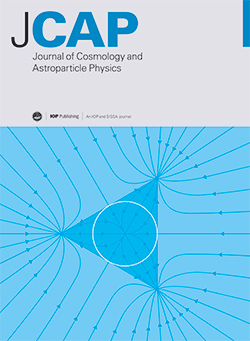Coherent self-interactions of dark matter in the Bullet Cluster
IF 5.3
2区 物理与天体物理
Q1 ASTRONOMY & ASTROPHYSICS
Journal of Cosmology and Astroparticle Physics
Pub Date : 2025-03-26
DOI:10.1088/1475-7516/2025/03/067
引用次数: 0
Abstract
Many models of dark matter include self-interactions beyond gravity. A variety of astrophysical observations have previously been used to place limits on the strength of such self-interactions. However, previous works have generally focused either on short-range interactions resulting in individual dark matter particles scattering from one another, or on effectively infinite-range interactions which sum over entire dark matter halos. In this work, we focus on the intermediate regime: forces with range much larger than dark matter particles' inter-particle spacing, but still shorter than the length scales of known halos. We show that gradients in the dark matter density of such halos would still lead to observable effects. We focus primarily on effects in the Bullet Cluster, where finite-range forces would lead either to a modification of the collision velocity of the cluster or to a separation of the dark matter and the galaxies of each cluster after the collision. We also consider constraints from the binding of ultrafaint dwarf galaxy halos, and from gravitational lensing of the Abell 370 cluster. Taken together, these observations allow us to set the strongest constraints on dark matter self-interactions over many orders of magnitude in range below ∼10 kpc, surpassing existing limits by orders of magnitude throughout.子弹星团中暗物质的相干自相互作用
许多暗物质模型包括引力之外的自相互作用。各种各样的天体物理观测已经被用来限制这种自我相互作用的强度。然而,以前的工作通常集中在导致单个暗物质粒子相互散射的短程相互作用上,或者集中在整个暗物质晕的有效无限范围相互作用上。在这项工作中,我们专注于中间状态:力的范围远远大于暗物质粒子的粒子间间距,但仍然短于已知晕的长度尺度。我们表明,这种晕的暗物质密度梯度仍然会导致可观察到的效应。我们主要关注子弹星系团的影响,在那里,有限范围的力会导致星系团碰撞速度的改变,或者导致碰撞后每个星系团的暗物质和星系的分离。我们还考虑了来自超矮星系晕的束缚和来自Abell 370星团的引力透镜的约束。综上所述,这些观测结果使我们能够在低于10 kpc的许多数量级范围内对暗物质自相互作用设定最强的约束,在整个数量级上超过现有的限制。
本文章由计算机程序翻译,如有差异,请以英文原文为准。
求助全文
约1分钟内获得全文
求助全文
来源期刊

Journal of Cosmology and Astroparticle Physics
地学天文-天文与天体物理
CiteScore
10.20
自引率
23.40%
发文量
632
审稿时长
1 months
期刊介绍:
Journal of Cosmology and Astroparticle Physics (JCAP) encompasses theoretical, observational and experimental areas as well as computation and simulation. The journal covers the latest developments in the theory of all fundamental interactions and their cosmological implications (e.g. M-theory and cosmology, brane cosmology). JCAP''s coverage also includes topics such as formation, dynamics and clustering of galaxies, pre-galactic star formation, x-ray astronomy, radio astronomy, gravitational lensing, active galactic nuclei, intergalactic and interstellar matter.
 求助内容:
求助内容: 应助结果提醒方式:
应助结果提醒方式:


